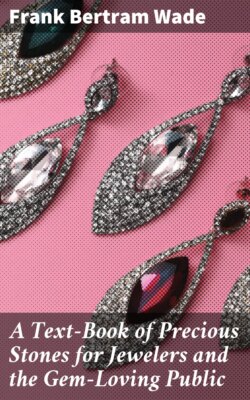Читать книгу A Text-Book of Precious Stones for Jewelers and the Gem-Loving Public - Frank Bertram Wade - Страница 11
На сайте Литреса книга снята с продажи.
DOUBLE REFRACTION
ОглавлениеTable of Contents
Explanation of Double Refraction. In Lesson II. we learned what is meant by refraction of light. While glass and a small number of precious stones (diamond, garnet, and spinel) bend light as was illustrated in Fig. 1, practically all the other stones cause a beam of light on entering them to separate, and the path of the light in the stone becomes double, as shown in Fig. 2.
This behavior is called double refraction. It may be used to distinguish those stones which are doubly refracting from those which are not. For example, in the case of a stone which is doubly refracting to a strong degree, such as a peridot (the lighter yellowish-green chrysolite is the same material and behaves similarly toward light), the separation of the light is so marked that the edges of the rear facets, as seen through the table, appear double when viewed through a lens. A zircon will also similarly separate light and its rear facets also appear double-lined as seen with a lens from the table of the stone. The rarer stones, sphene and epidote, likewise exhibit this property markedly. Some colorless zircons, when well cut, so closely resemble diamonds that even an expert might be deceived, if caught off his guard, but this simple test of looking for the doubled lines at the back of the stone would alone serve to distinguish the two stones.
Fig. 2.
A Simple but very Valuable Test for the Kind of Refraction of a Cut Stone. In the case of most of the other doubly refracting stones the degree of separation is much less than in peridot and zircon, and it takes a well-trained and careful eye to detect the doubling of the lines. Here a very simple device will serve to assist the eye in determining whether a cut stone is singly or doubly refracting. Expose the stone to direct sunlight and hold an opaque white card a few inches from the stone, in the direction of the sun, so as to get the bright reflections from within the stone reflected onto the card.
If the material is singly refractive (as in the case of diamond, garnet, spinel, and glass), single images of each of the reflecting facets will appear on the card, but if doubly refracting—even if slightly so—double images will appear. When the stone is slightly moved, these pairs of reflections will travel together as pairs and not tend to separate. The space between the two members of each pair of reflections serves to give a rough idea of the degree of the double refraction of the material if compared with the space between members in the case of some other kind of stone held at the same distance from the card. Thus zircon separates the reflections widely. Aquamarine, which is feebly doubly refracting, separates them but slightly.
It will be seen at once that we have here a very easily applied test and one that requires no costly apparatus. It is, furthermore, a sure test, after a little practice. For example, if one has something that looks like a fine emerald, but that may be glass, all one need to do is to expose it in the sun, as above indicated. If real emerald, double images will be had (very close together, because emerald is but feebly doubly refracting). If glass, the images on the card will be single.
Similarly, ruby can at once be distinguished from even the finest garnet or ruby spinel, as the last two are singly refracting. So, too, are glass imitations of ruby and ruby doublets (which consist of glass and garnet). This test cannot injure the stone, it may be applied to mounted stones, and it is reliable. For stones of very deep color this test may fail for lack of sufficiently brilliant reflections. In such a case hold the card beyond the stone and let the sunlight shine through the stone onto the card, observing whether the spots of light are single or double.
The table below gives the necessary information as to which stones show double and which single refraction.
